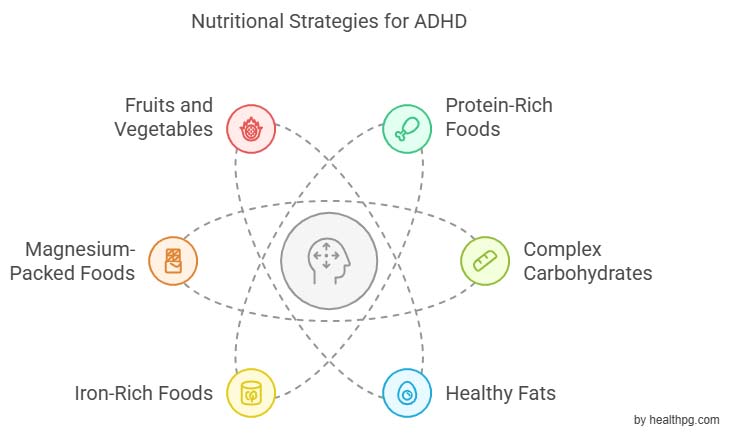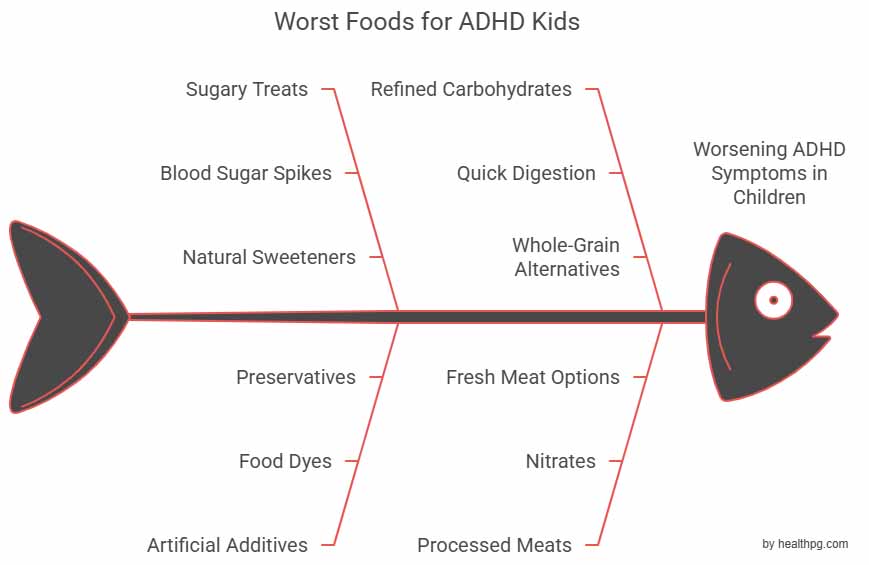As a parent, have you ever wondered if the food on your child’s plate could help ease their restlessness or sharpen their focus? It’s a question that pops up more often than you might think, especially for parents of kids with Attention Deficit Hyperactivity Disorder. The good news? An ADHD diet for kids could make a real difference in managing symptoms. In this article, we’ll take a closer look at what an ADHD diet plan for kids involves, the best foods to serve your child, the worst foods to steer clear of, and some tasty recipes to help you get started.
Why Focus on an ADHD Diet Plan for Kids?
Children with ADHD often struggle with impulsivity, lack of focus, and mood swings. These challenges can sometimes be exacerbated by what they eat. Research suggests that certain foods may either worsen or improve ADHD symptoms. For example, processed snacks high in sugar and artificial additives have been linked to increased hyperactivity, while nutrient-dense whole foods like fruits, vegetables, and lean proteins seem to promote better brain health. By creating a thoughtful ADHD diet plan for kids, parents can help stabilize energy levels, enhance concentration, and reduce irritability.
Foods to Eat with an ADHD Child
When planning meals for a child with ADHD, it’s important to include foods rich in vitamins, minerals, and healthy fats that support brain function. Here are some key categories:

- Protein-Rich Foods: Protein helps balance blood sugar levels and provides amino acids needed for neurotransmitter production. Include:
- Eggs
- Chicken and turkey breast
- Lentils and beans
- Greek yogurt
- Nuts and seeds (if no allergies)
- Complex Carbohydrates: Unlike simple carbs found in sugary snacks, complex carbohydrates release energy slowly, preventing spikes and crashes in mood and behavior. Try:
- Whole grain bread and pasta
- Brown rice and quinoa
- Sweet potatoes
- Oats
- Healthy Fats: Omega-3 fatty acids are particularly beneficial for brain health and have been shown to reduce ADHD symptoms. Good sources include:
- Salmon, mackerel, and sardines
- Walnuts and flaxseeds
- Avocado
- Olive oil
- Iron-Rich Foods: Low iron levels have been associated with worsening ADHD symptoms. Incorporate:
- Spinach and kale
- Red meat (in moderation)
- Fortified cereals
- Pumpkin seeds
- Magnesium-Packed Foods: Magnesium helps relax muscles and nerves, which can aid sleep and reduce anxiety. Options include:
- Bananas
- Almonds
- Dark chocolate (70% cocoa or higher)
- Leafy greens
- Fruits and Vegetables: Colorful produce offers antioxidants and fiber, both of which contribute to overall well-being. Encourage:
- Berries (blueberries, strawberries)
- Oranges and kiwis
- Broccoli and carrots
- Bell peppers
Worst Foods for ADHD Kids
Just as there are foods that nourish the brain, others can trigger or worsen ADHD symptoms.

- Sugary Treats: Candy, cookies, cakes, and soda cause rapid blood sugar spikes followed by crashes, leading to irritability and hyperactivity. Limit intake and opt for natural sweeteners like honey or maple syrup when possible.
- Artificial Additives: Food dyes, preservatives, and flavor enhancers commonly found in packaged snacks and drinks can increase hyperactivity in sensitive children. Read labels carefully and avoid products containing ingredients like Red 40, Yellow 5, and sodium benzoate.
- Refined Carbohydrates: White bread, pastries, and chips digest quickly, causing similar effects to sugar. Replace them with whole-grain alternatives whenever possible.
- Caffeinated Beverages: Soda, energy drinks, and even tea or coffee can overstimulate a child’s nervous system, making it harder for them to concentrate or wind down at bedtime.
- Processed Meats: Hot dogs, bacon, and deli meats often contain nitrates and other chemicals that may negatively affect brain function. Choose fresh cuts of meat instead.
- Dairy Sensitivities: Some children with ADHD may experience adverse reactions to dairy products. If you suspect lactose intolerance or sensitivity, try eliminating milk, cheese, and yogurt temporarily to see if symptoms improve.
ADHD Diet for Kids Recipes
Eating smart doesn’t mean boring meals. These recipes use ADHD-friendly ingredients and come together fast.
Berry Banana Smoothie Bowl
Packed with antioxidants from berries, healthy fats from nuts, and natural sweetness from bananas, this dish is both delicious and brain-boosting.
Time and Temperature:
- Prep Time: 5 minutes
- Cook Time: 0 minutes (no cooking required)
- Serving Temperature: Cold
Equipment Needed:
- Blender
- Mixing spoon
- Bowl
- Knife (for slicing toppings)
Nutritional Information (per serving):
- Calories: 250
- Protein: 6g
- Carbohydrates: 35g
- Fiber: 8g
- Fat: 10g (mostly healthy fats from nuts and seeds)
Substitutions:
- Berries: Swap mixed berries for mango chunks or pineapple for a tropical twist.
- Milk: Use coconut milk, oat milk, or regular cow’s milk instead of almond milk.
- Toppings: Replace granola with crushed whole-grain cereal or add fresh fruit like kiwi or strawberries.
Turkey and Veggie Wraps
These colorful wraps are a quick and easy lunch option packed with lean protein, fiber, and vitamins. They’re portable, kid-friendly, and customizable to suit your child’s preferences.
Time and Temperature:
- Prep Time: 10 minutes
- Cook Time: 0 minutes (no cooking required)
- Serving Temperature: Room temperature or chilled
Equipment Needed:
- Cutting board
- Knife (for slicing veggies and rolling wraps)
- Spoon or spatula (for spreading hummus)
Nutritional Information (per wrap):
- Calories: 300
- Protein: 15g
- Carbohydrates: 30g
- Fiber: 6g
- Fat: 12g (healthy fats from avocado and hummus)
Substitutions:
- Turkey: Substitute with grilled chicken, roasted tofu, or even canned tuna for variety.
- Hummus: Use mashed avocado, cream cheese, or pesto as an alternative spread.
- Veggies: Add cucumber slices, bell peppers, or shredded lettuce for extra crunch and nutrients.
Baked Salmon with Quinoa and Steamed Broccoli
This wholesome dinner is rich in omega-3 fatty acids, protein, and fiber—key nutrients for brain health and balanced energy. It’s simple to prepare yet feels gourmet enough for the whole family to enjoy.
Time and Temperature:
- Prep Time: 10 minutes
- Cook Time: 20 minutes
- Oven Temperature: 375°F (190°C)
- Serving Temperature: Warm
Equipment Needed:
- Baking sheet (lined with parchment paper for easy cleanup)
- Small pot (for cooking quinoa)
- Steamer basket or microwave-safe bowl (for broccoli)
- Mixing spoon
Nutritional Information (per serving):
- Calories: 400
- Protein: 30g
- Carbohydrates: 35g
- Fiber: 7g
- Fat: 15g (rich in omega-3s from salmon)
Substitutions:
- Salmon: Swap with baked cod, tilapia, or even chickpea patties for a vegetarian option.
- Quinoa: Use brown rice, couscous, or cauliflower rice if preferred.
- Broccoli: Substitute with green beans, zucchini, or asparagus for steaming.

